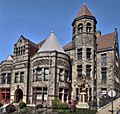Carnegie library facts for kids
A Carnegie library is a special kind of library. These libraries were built with money given by a very rich man named Andrew Carnegie. He helped build over 2,500 libraries around the world!
Contents
What is a Carnegie Library?
Between 1883 and 1919, Andrew Carnegie gave money to many cities and towns. This money was specifically for building new libraries. These libraries became known as Carnegie libraries.
How Were Carnegie Libraries Built?
Carnegie had a special deal for towns that wanted a library. He would give them money for the building itself. In return, the city or town had to do two things:
- They had to provide the land where the library would be built.
- They had to promise to spend 10% of the building's cost each year. This money would be used to run the library and keep it open.
This deal helped many communities get a library. It also made sure the libraries would be used and maintained.
What Do They Look Like?
Many Carnegie library buildings are still standing today. Most of them are made of brick. You might notice they often have a staircase leading up to the front door. This design was common for public buildings at the time.
Some of these old buildings are still used as libraries. Others have been changed and are now used for different purposes.
Images for kids
-
Andrew Carnegie, c. 1905, National Portrait Gallery
-
Plaque at the Taunton Public Library in Massachusetts
-
Carnegie Free Library of Braddock in Braddock, Pennsylvania, built in 1888, was the first Carnegie Library in the United States to open (1889) and the first of four to be fully endowed.
-
The Historical Society of Washington, D.C. is located in a former Carnegie library and is on the U.S. National Register of Historic Places.
-
Carnegie Library, built in 1901 in Guthrie, Oklahoma
-
Carnegie Library, built in 1904 in Akron, Ohio
-
Carnegie Public Library, built in 1904 in Tyler, Texas
-
Carnegie Library, built in 1908 in Hokitika, New Zealand
-
West Tampa Free Public Library, built in 1914 in Tampa, Florida
-
Beaumont Library built in 1914 in Beaumont, California
-
St. Petersburg Public Library, built in 1915 in St. Petersburg, Florida
-
Bayliss Library, built in 1917 in Glenn County, California
See also
 In Spanish: Biblioteca Carnegie para niños
In Spanish: Biblioteca Carnegie para niños



















